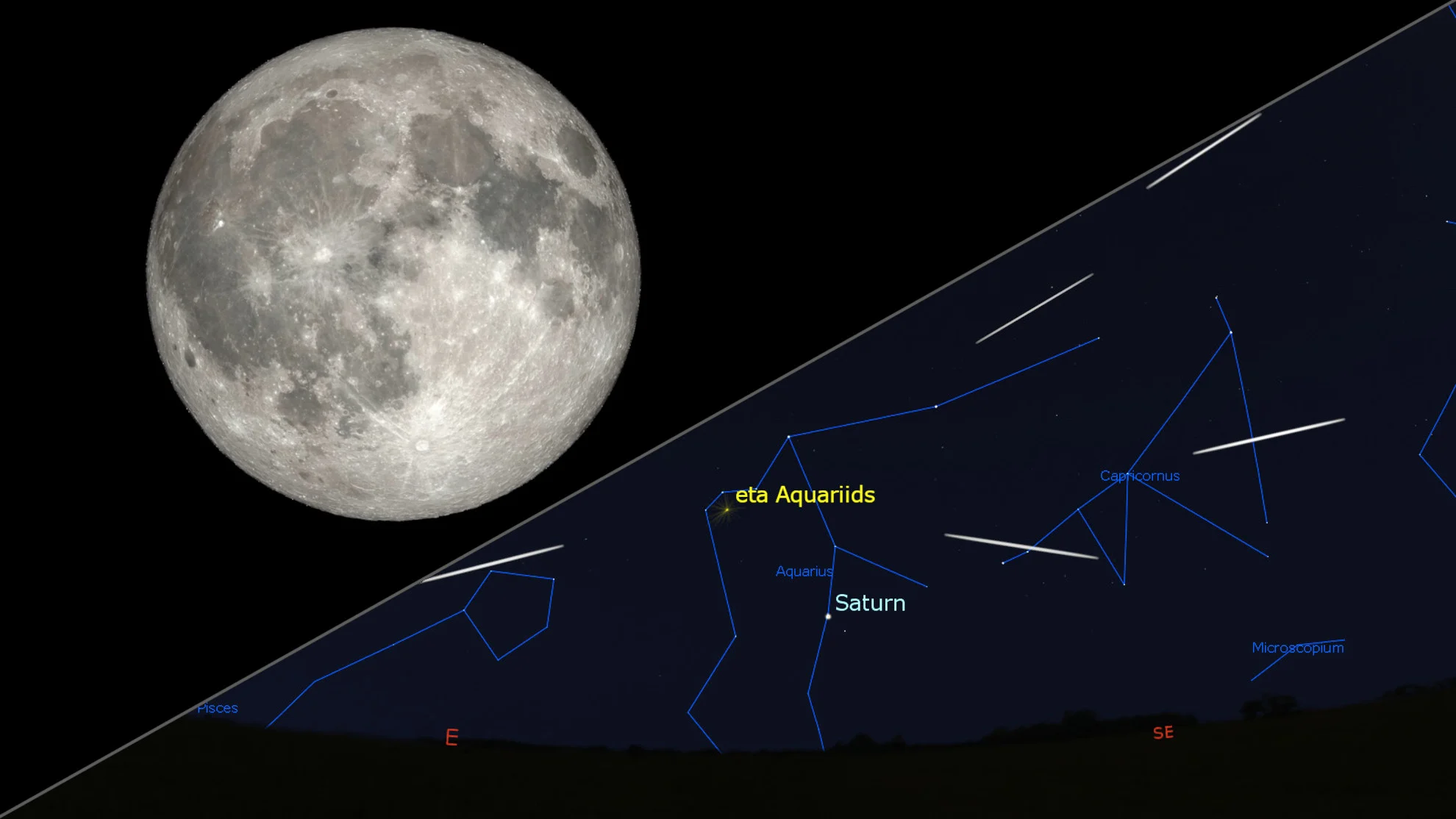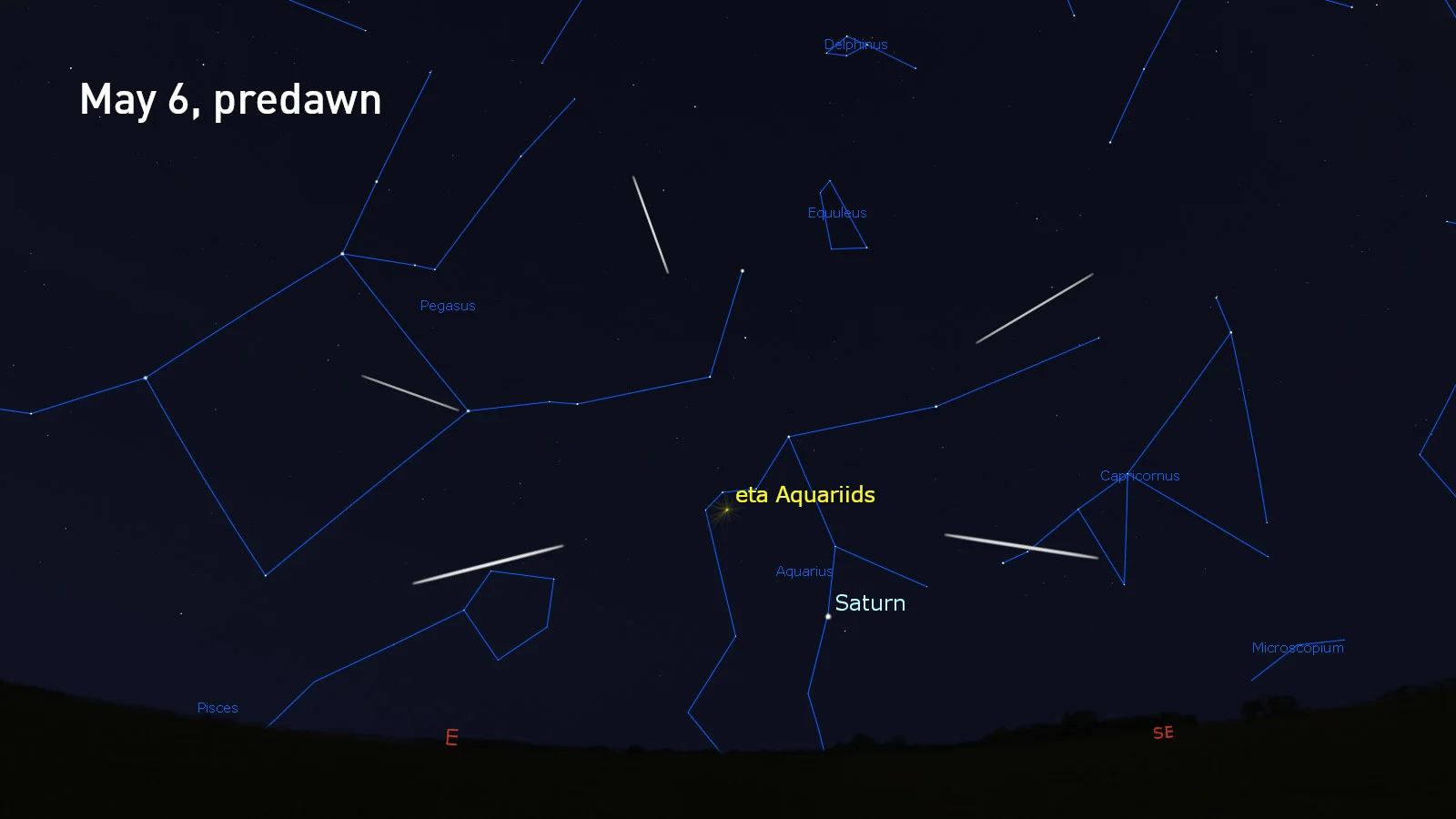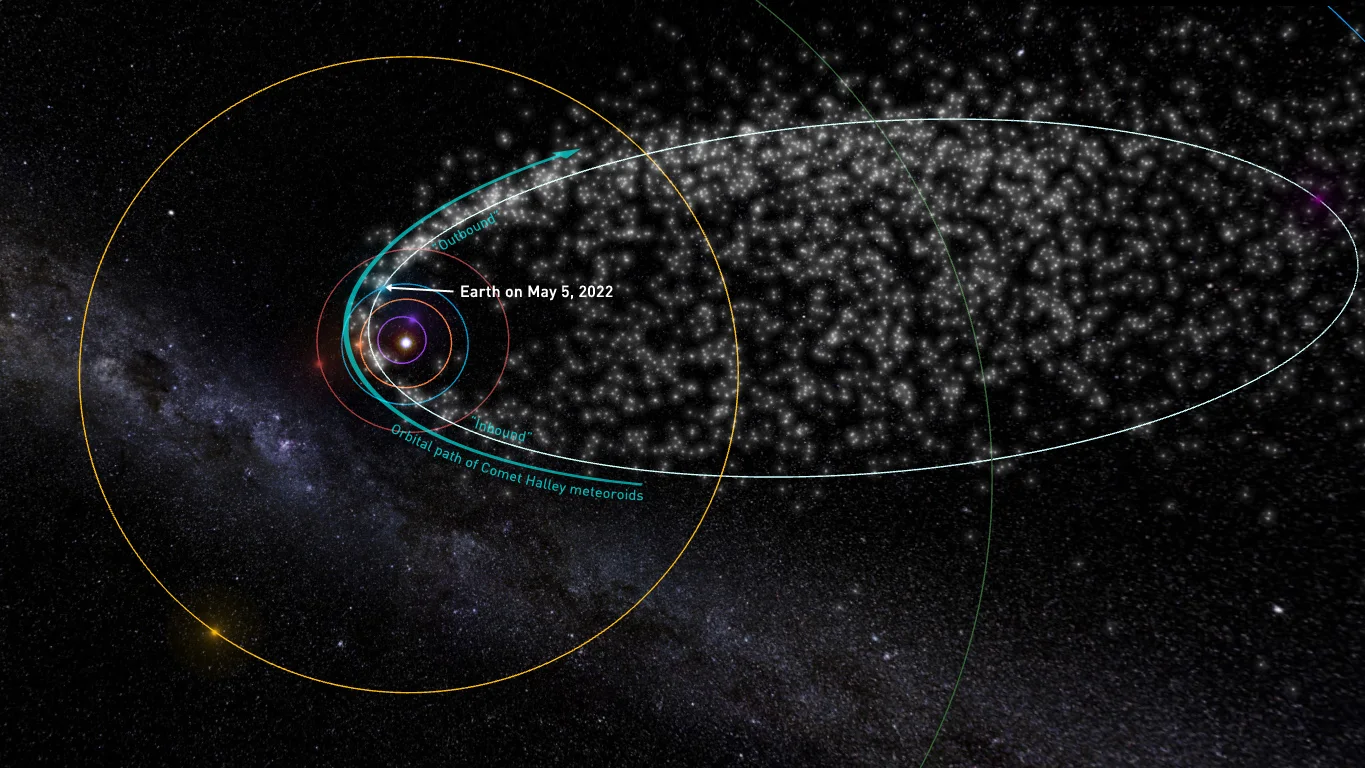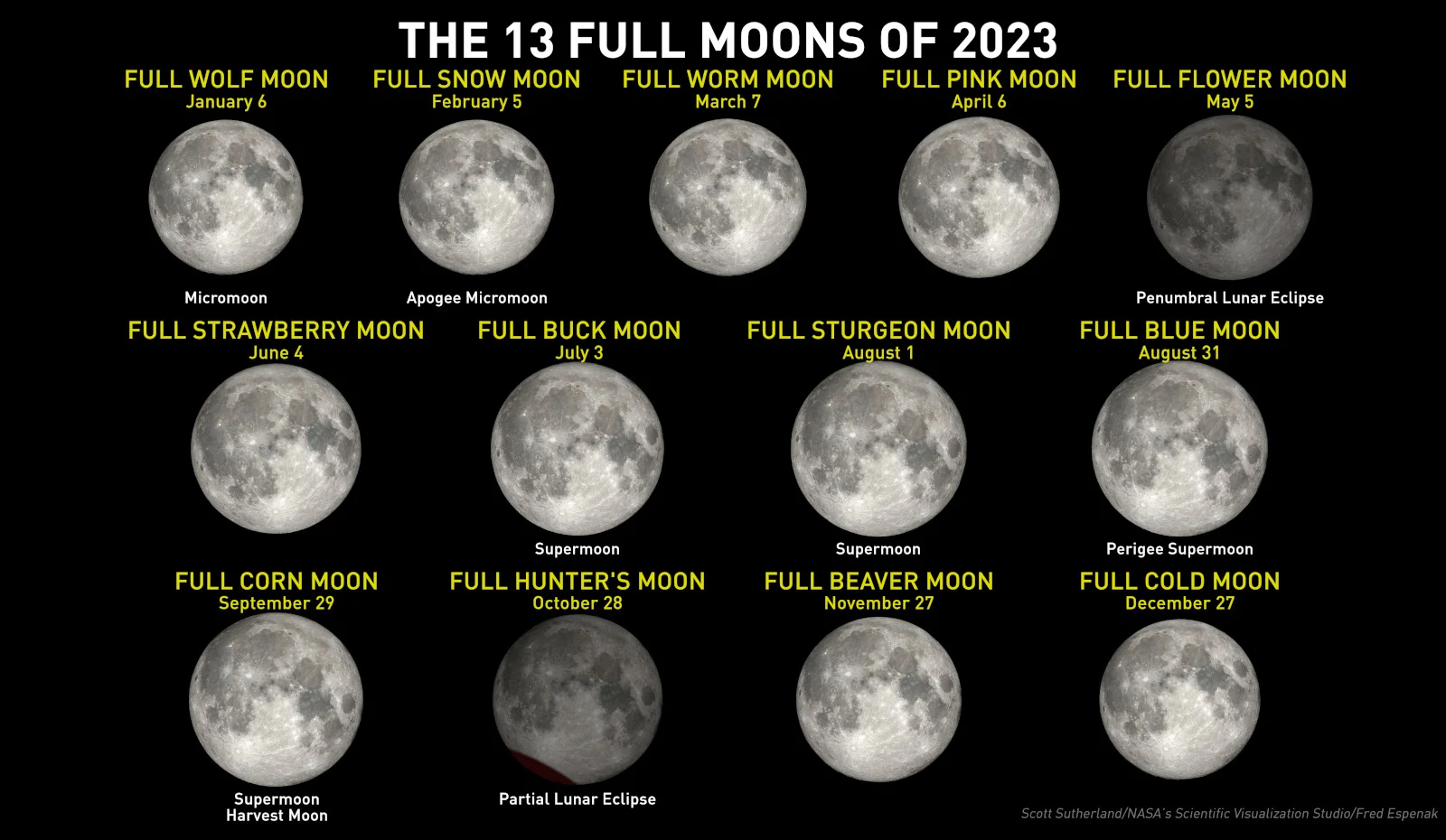
The Full Flower Moon and eta Aquariid meteor shower light up the night this week
Despite the Full Moon, this could be a great year for the annual eta Aquariid meteor shower.
Eyes to the sky this week, to see both the Full Flower Moon and what could be one of the best displays of the eta Aquariid meteor shower in years.
Every year, from late April through the month of May, Earth passes through a stream of ice and dust left behind by Halley's Comet. The resulting meteor shower, known as the eta Aquariids, is active from around April 19 to May 28, and in 2023 it peaks on the nights of May 5 and 6.

The radiant of the eta Aquariid meteor shower, at roughly 4:30 a.m. local time, on May 6. Credit: Stellarium/Scott Sutherland
The best time to see the eta Aquariids is in the hours just before dawn on the mornings of May 5 and May 6. That is when the radiant — the point in the sky where the meteors appear to radiate from — rises above the eastern horizon.
The eta Aquariids typically produce around 50 meteors per hour under ideal conditions — having a clear, dark sky, with the meteor shower radiant directly overhead. Most observers will see about half that number, and the bright moonlight may cut that down even further.

This graphic shows the orbit and debris stream of Comet Halley, noting the direction the stream is moving, with the "inbound" producing the October Orionids and the "outbound" resulting in the May eta Aquariids. Credit: meteorshowers.org/Scott Sutherland
However, there is an exciting twist to this year's eta Aquariids.
The International Meteor Organization says that we may pass through a slightly denser part of Comet Halley's debris trail around the meteor shower's peak, which is expected to result in more meteors than usual.
Although there's no way to be sure about how much enhanced activity this will produce, the IMO suggests watching for elevated activity on the mornings of May 4, 5, and 6. Any enhanced activity that does occur could, perhaps, cancel out the effects of the Moon's bright light.
Watch for Persistent Trains!
While some meteor showers, like the Lyrids and the Perseids, are well-known for their bright fireballs, the eta Aquariids produce a remarkable phenomenon due to their exceptional speed.
As Comet Halley meteoroids streak through the air at 240,000 km/h, they result in the usual brief meteor flashes. If you watch closely, though, you may also see another phenomenon. After some meteors wink out, a glowing trail is left behind in their wake, which can float in the air for minutes or even hours. These are known as persistent trains
Watch below: What is a persistent train?
Persistent trains have only rarely been recorded. As a result, scientists are still figuring out what causes them, and they've come up with two leading explanations.
The first is that the meteoroids travel fast enough to strip electrons from the air molecules, leaving them in an ionized state. Then, as the air molecules snatch up stray electrons from their surroundings, they release energy in the form of light. Since this process can take much longer than the original meteor flash, the 'train' appears fainter and persists for some time after the meteor flash ends.
The other idea involves a process known as 'chemiluminescence'. Metals vaporizing off the fast-moving meteoroid's surface can chemically react with ozone and oxygen in the air to produce a glow.
One of these explanations may account for persistent trains, or both may cover different occurrences at different times and even between individual meteors. It will take more sightings of these to explain them fully.
The Full Flower Moon and Penumbral Lunar Eclipse
The May Full Moon occurs on Friday the 5th, at roughly 1:35 p.m. EDT. According to NASA, with that timing, the Moon will appear full from May 4 through May 6, or from early Thursday morning through early Sunday morning.
This Full Moon is also known as the Full Flower Moon.

The Full Moons of 2023. Credit: Scott Sutherland/NASA's Scientific Visualization Studio/Fred Espenak
According to the TimeandDate.com, "The May Full Moon is known as Flower Moon to signify the flowers that bloom during this month. Other names for the Full Moon in May are Corn Planting Moon, and Milk Moon from Old English/Anglo-Saxon."
Coincidentally, this is the third year in a row that a lunar eclipse will take place during the May Full Moon.
The previous two, in 2021 and 2022, were both super total lunar eclipses. Thus, they both took place when the Moon was closer to Earth than normal ('super'), and during both the Moon passed directly through the dark centre of Earth's shadow (the 'umbra'), which turned the surface of the Moon a dusky red colour.
This year, the event will be much more challenging to see.
Firstly, if you want to see it in person, you'd have to be on the other side of the planet. The only places it will be visible from in North America are the Hawaiian Islands, and the Andreanof and Rat Islands in the North Pacific, to the west of Alaska.
Secondly, it will be difficult to notice that anything is changing with the Moon, because this is only a penumbral lunar eclipse.

While the Moon passes straight through the middle of Earth's shadow during a total lunar eclipse, for a penumbral eclipse, it only sweeps through the faint edge of the shadow. Thus, even during maximum eclipse, there will only be a slight dimming of the Moon's reflected light.
Tips for meteor shower watching
Meteor showers are events that nearly everyone can watch. No special equipment is required. In fact, binoculars and telescopes make it harder to see meteor showers, by restricting your field of view. However, there are a few things to keep in mind so you don't miss out on these amazing events.
The three best practices for observing the night sky are:
Check the weather,
Get away from light pollution, and
Be patient.
Clear skies are essential. Even a few hours of cloudy skies can ruin your chances of watching an event such as a meteor shower. So, be sure to check The Weather Network on TV, on our website, or from our app, and look for my articles on our Space News page, just to be sure that you have the most up-to-date sky forecast.
Next, you need to get away from city light pollution. If you look up into the sky from home, what do you see? The Moon, a planet or two, perhaps a few bright stars such as Vega, Betelgeuse and Procyon, as well as some passing airliners? If so, there's too much light pollution in your area to get the most out of a meteor shower. You might catch an exceptionally bright fireball if one happens to fly past overhead, but that's likely all you'll see. So, to get the most out of your stargazing and meteor watching, get out of the city. The farther away you can get, the better.
Watch: What light pollution is doing to city views of the Milky Way
For most regions of Canada, getting out from under light pollution is simply a matter of driving outside of your city, town or village until a multitude of stars is visible above your head.
In some areas, especially in southern Ontario and along the St. Lawrence River, the concentration of light pollution is too high. Getting far enough outside of one city to escape its light pollution tends to put you under the light pollution dome of the next city over. The best options for getting away from light depend on your location. In southwestern Ontario and the Niagara Peninsula, the shores of Lake Erie can offer some excellent views. In the GTA and farther east, drive north and seek out the various Ontario provincial parks or Quebec provincial parks. Even if you're confined to the parking lot after hours, these are usually excellent locations from which to watch (and you don't run the risk of trespassing on someone's property).
If you can't get away, the suburbs can offer at least a slightly better view of the night sky. Here, the key is to limit the amount of direct light in your field of view. Dark backyards, sheltered from street lights by surrounding houses and trees, are your best haven. The video above provides a good example of viewing based on the concentration of light pollution in the sky. Also, check for dark sky preserves in your area.
When viewing a meteor shower, be mindful of the phase of the Moon. Meteor showers are typically at their best when viewed during the New Moon or Crescent Moon. However, a Gibbous or Full Moon can be bright enough to wash out all but the brightest meteors. Since we can't get away from the Moon, the best option is just to time your outing right, so the Moon has already set or is low in the sky. Also, you can angle your field of view to keep the Moon out of your direct line of sight. This will reduce its impact on your night vision and allow you to spot more meteors.
Once you've verified you have clear skies and you've limited your exposure to light pollution, this is where being patient comes in.
For best viewing, your eyes need some time to adapt to the dark. Give yourself at least 20 minutes, but 30-45 minutes is best for your eyes to adjust from being exposed to bright light.
Note that this, likely more than anything else, is the one thing that causes the most disappointment when it comes to watching a meteor shower.
If you step out into your backyard from a brightly lit home and looking up for a few minutes, you might be lucky enough to catch a rare bright fireball meteor. However, it's far more likely that you won't see anything at all. Meteors may be streaking overhead, but it takes time for our eyes to adjust, so that we can actually pick out those brief flashes of light. Waiting for at least twenty minutes, while avoiding sources of light during that time (streetlights, car headlights and interior lights, and smartphone screens) dramatically improves your chances of avoiding disappointment.
Sometimes, avoiding your smartphone isn't an option. In this case, set the display to reduce the amount of blue light it gives off and reduce the screen's brightness. That way, it will have less of an impact on your night vision.
You can certainly gaze into the starry sky while you are letting your eyes adjust. You may even see a few of the brighter meteors as your eyes become accustomed to the dark.
Once you're all set, just look straight up and enjoy the view!






